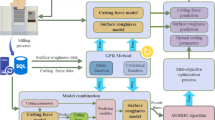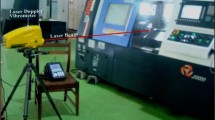Abstract
Surface roughness is a technical requirement for machined products and one of the main product quality specifications. In order to avoid the costly trial-and-error process in machining parameters determination, the Gaussian process regression (GPR) was proposed for modeling and predicting the surface roughness in end face milling. Cutting experiments on C45E4 steel were conducted and the results were used for training and verifying the GPR model. Three parameters, spindle speed, feed rate, and depth of cut were considered; the experiment results showed that depth of cut is the main factor affecting the surface roughness and regression results showed that the GPR model has a good precision in predicting the surface roughness in different cutting conditions. The prediction accuracy was nearly about 84.3 %. Based on the GPR prediction model, 3D-maps of surface roughness under various cutting parameters could be obtained. It is very concise and useful to select the appropriate cutting parameters according to the maps. As experimental results did not conform to the empirical knowledge, frequency spectrums of the tool were analyzed according to the 3D-maps, it was found that tool vibration is also a crucial factor affecting the machined surface quality.
Similar content being viewed by others
References
Halevi G, Weill RD (1995) Principles of process planning: a logical approach. Springer, Berlin
Kadirgama K, Muhamad MN, Ruzaimi M, Rejab M (2008) Optimization of surface roughness in end milling on mould aluminium alloys (AA6061-T6) using response surface method and radian basis function network. Jor J Mech Ind Eng 2(4):209–214
Abouelatta OB, Madl J (2001) Surface roughness prediction based on cutting parameters and tool vibrations in turning operations. J Mater Process Tech 118 (1):269–277
Benardos PG, Vosniakos G (2003) Predicting surface roughness in machining: a review. Int J Mach Tools Manuf 43 (8):833–844
Lou MS, Chen JC, Li CM (1998) Surface roughness prediction technique for CNC end-milling. J Ind Technol 15 (1):1–6
Zhang JZ, Chen JC, Kirby ED (2007) Surface roughness optimization in an end-milling operation using the Taguchi design method. J Mater Process Technol 184 (1):233–239
Bozdemir M, Aykut Ş (2012) Optimization of surface roughness in end milling Castamide. Int J Adv Manuf Technol 62 (5-8):495–503
Elhami S, Razfar MR, Farahnakian M, Rasti A (2013) Application of GONNS to predict constrained optimum surface roughness in face milling of high-silicon austenitic stainless steel. Int J Adv Manuf Technol 66 (5–8):975–986
Fuh KH, Wu CF (1995) A proposed statistical model for surface quality prediction in end-milling of Al alloy. Int J Mach Tools Manuf 35 (8):1187–1200
Benardos PG, Vosniakos GC (2002) Prediction of surface roughness in CNC face milling using neural networks and Taguchi’s design of experiments. Robot Cim-Int Manuf 18 (5):343–354
Lela B, Bajiç D, Joziç S (2009) Regression analysis, support vector machines, and Bayesian neural network approaches to modeling surface roughness in face milling. Int J Adv Manuf Technol 42 (11-12):1082–1088
Razfar MR, Zinati RF, Haghshenas M (2011) Optimum surface roughness prediction in face milling by using neural network and harmony search algorithm. Int J Adv Manuf Technol 52 (5-8):487–495
Antoniadis A, Savakis C, Bilalis N, Balouktsis A (2003) Prediction of surface topomorphy and roughness in ball-end milling. Int J Adv Manuf Technol 21 (12):965–971
Seeman M, Ganesan G, Karthikeyan R, Velayudham A (2010) Study on tool wear and surface roughness in machining of particulate aluminum metal matrix composite-response surface methodology approach. Int J Adv Manuf Technol 48 (5-8):613–624
Prakasvudhisarn C, Kunnapapdeelert S, Yenradee P (2009) Optimal cutting condition determination for desired surface roughness in end milling. Int J Adv Manuf Technol 41 (5–6):440–451
Tsao CC (2009) Grey-Taguchi method to optimize the milling parameters of aluminum alloy. Int J Adv Manuf Technol 40 (1–2):41–48
Kadirgama K, Muhamad MN (2009) Surface roughness analysis in end milling with response ant colony optimization 6th International Conference on Numerical Analysis in Engineering
Daymi A, Boujelbene M, Linares JM, Bayraktar E, Amara AB (2009) Influence of workpiece inclination angle on the surface roughness in ball end milling of the titanium alloy Ti-6Al-4V. J Achieve Mater Manuf Eng 35 (1):79–86
Zhongxiang H, Lei Z, Jiaxu T, Xuehong M, Xiaojun S (2009) Evaluation of three-dimensional surface roughness parameters based on digital image processing. Int J Adv Manuf Technol 40 (3–4):342–348
Kurt M, Bagci E, Kaynak Y (2009) Application of Taguchi methods in the optimization of cutting parameters for surface finish and hole diameter accuracy in dry drilling processes. Int J Adv Manuf Technol 40 (5–6):458–469
Suresh PVS, Venkateswara Rao P, Deshmukh SG (2002) A genetic algorithmic approach for optimization of surface roughness prediction model. Int J Mach Tools Manuf 42 (6):675– 680
Palani S, Natarajan U (2011) Prediction of surface roughness in CNC end milling by machine vision system using artificial neural network based on 2D Fourier transform. Int J Adv Manuf Technol 54 (9–12):1033–1042
Chen CC, Liu NM, Chiang KT, Chen H (2012) Experimental investigation of tool vibration and surface roughness in the precision end-milling process using the singular spectrum analysis. Int J Adv Manuf Technol 63 (5–8):797–815
Chandrasekaran M, Muralidhar M, Krishna CM, Dixit US (2010) Application of soft computing techniques in machining performance prediction and optimization: a literature review. Int J Adv Manuf Technol 46 (5–8):445–464
Williams CK, Rasmussen CE (1996) Gaussian processes for regression. MIT, Cambridge
Vapnik V (2000) The nature of statistical learning theory. Springer, Berlin
Smola AJ, Schölkopf B (2004) A tutorial on support vector regression. Stat Comput 14 (3):199–222
Chen T, Morris J, Martin E (2007) Gaussian process regression for multivariate spectroscopic calibration. Chemometr Intell Lab 87 (1):59–71
Likar B, Kocijan J (2007) Predictive control of a gasCliquid separation plant based on a Gaussian process model. Comput Chem Eng 31 (3):142–152
Park C, Huang JZ, Ding Y (2011) Domain decomposition approach for fast Gaussian Process Regression of large apatial data sets. J Mach Learn Res 12:1697–1728
MacKay D J (1997) Gaussian processes-a replacement for supervised neural networks?. NIPS97 Tutorial
Rasmussen CE (2004) Gaussian processes in machine learning, in Advanced Lectures on Machine Learning. Springer, Berlin Heidelberg New York, pp 63–71
Lo SP (2003) An adaptive-network based fuzzy inference system for prediction of workpiece surface roughness in end milling. J Mater Process Technol 142 (3):665–675
El-Mounayri H, Dugla Z, Deng H (2003) Prediction of surface roughness in end milling using swarm intelligence. Proceedings of the IEEE, pp 220–227
Chryssolouris G, Guillot M (1990) A comparison of statistical and AI approaches to the selection of process parameters in intelligent machining. J Manuf Sci E-T ASME 112:112–131
Altintas Y, Budak E (1995) Analytical prediction of stability lobes in milling. Cirp Ann-Manuf Technol 44 (1):357–362
Ismail F, Soliman E (1997) A new method for the identification of stability lobes in machining. Int J Mach Tools Manuf 37 (6):763–774
Insperger T, Stépán G (2001) Semi-discretization of delayed dynamical systems. Proceedings of the ASME 6
Insperger T, Stépán G (2004) Updated semi-discretization method for periodic delay-differential equations with discrete delay. Int J Numer Meth Fl 61 (1):117–141
Ding Y, Zhu L, Zhang X, Ding H (2010) A full-discretization method for prediction of milling stability. Int J Mach Tools Manuf 50 (5):502–509
Author information
Authors and Affiliations
Corresponding author
Rights and permissions
About this article
Cite this article
Zhang, G., Li, J., Chen, Y. et al. Prediction of surface roughness in end face milling based on Gaussian process regression and cause analysis considering tool vibration. Int J Adv Manuf Technol 75, 1357–1370 (2014). https://doi.org/10.1007/s00170-014-6232-6
Received:
Accepted:
Published:
Issue Date:
DOI: https://doi.org/10.1007/s00170-014-6232-6




